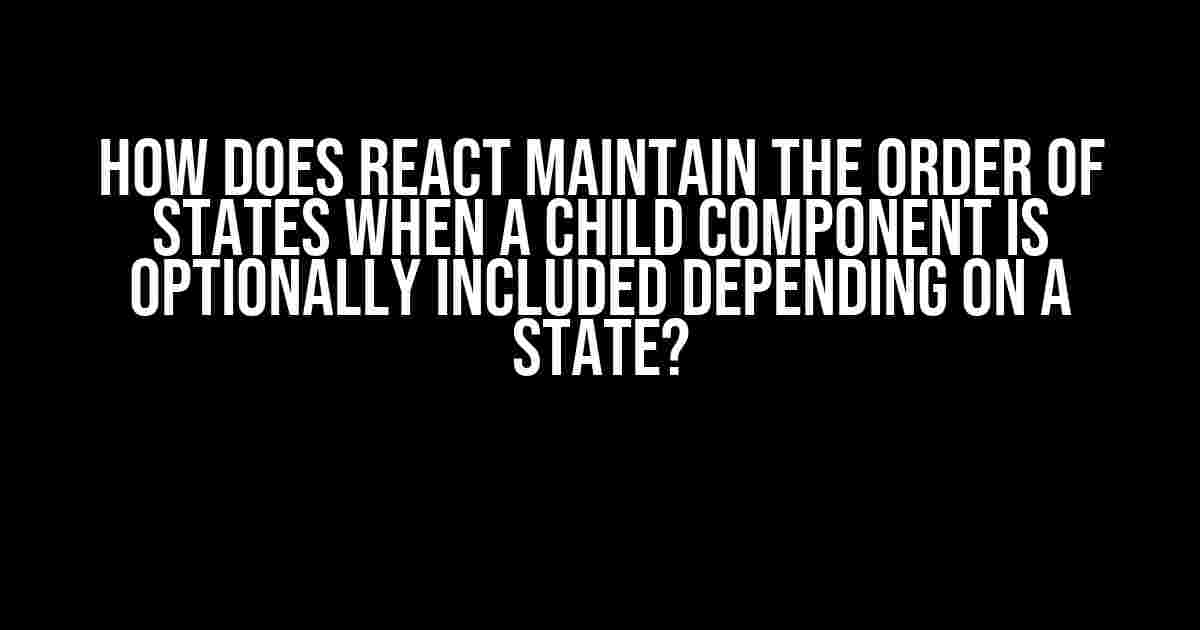Are you tired of dealing with the complexities of state management in React? Do you find yourself wondering how React keeps track of state changes when a child component is conditionally rendered based on a parent state? Well, wonder no more! In this article, we’ll delve into the world of React state management and explore how it maintains the order of states when a child component is optionally included depending on a state.
The Problem: Conditional Rendering and State Management
Imagine you have a parent component that renders a child component conditionally based on a state. For example, let’s say you have a `Toggle` component that renders a `Modal` component only when a certain state is true:
class Toggle extends React.Component {
constructor(props) {
super(props);
this.state = {
isVisible: false
};
}
toggleModal = () => {
this.setState({ isVisible: !this.state.isVisible });
}
render() {
return (
{this.state.isVisible && In this example, the `Modal` component is only rendered when the `isVisible` state is true. But what happens when the state changes and the `Modal` component is removed from the DOM? Does React still maintain the state of the `Modal` component?
The Solution: React’s State Management
React’s state management system is designed to handle conditional rendering and state changes seamlessly. When a state changes, React re-renders the component with the updated state. But how does it maintain the order of states when a child component is conditionally included?
The answer lies in React’s reconciliation algorithm. When the state changes, React performs a reconciliation to determine what changes need to be applied to the DOM. This process is divided into two phases: the “diff” phase and the “patch” phase.
The Diff Phase
In the “diff” phase, React compares the previous render with the new render to determine what changes need to be applied to the DOM. This phase is crucial in maintaining the order of states because it allows React to keep track of the state changes.
During the “diff” phase, React creates a virtual DOM, which is a lightweight in-memory representation of the real DOM. The virtual DOM is used to compute the differences between the previous render and the new render. This computation is done using a diffing algorithm, which compares the virtual DOM with the real DOM.
The Patch Phase
In the “patch” phase, React applies the changes to the DOM. This phase is where React updates the DOM with the new state. The patch phase is also responsible for maintaining the order of states.
During the patch phase, React iterates through the virtual DOM and applies the changes to the real DOM. This process is done in a way that maintains the order of states. For example, if a child component was conditionally included based on a state, React will re-render the child component with the updated state.
State Management in Action
Let’s revisit our previous example and see how React’s state management system maintains the order of states:
class Toggle extends React.Component {
constructor(props) {
super(props);
this.state = {
isVisible: false,
modalCount: 0
};
}
toggleModal = () => {
this.setState({ isVisible: !this.state.isVisible });
}
incrementModalCount = () => {
this.setState({ modalCount: this.state.modalCount + 1 });
}
render() {
return (
{this.state.isVisible && (
In this example, we’ve added a new state `modalCount` to the `Toggle` component. We’ve also added a new method `incrementModalCount` that increments the `modalCount` state.
When we toggle the `Modal` component, React maintains the order of states by re-rendering the `Modal` component with the updated `modalCount` state. This is because React’s reconciliation algorithm ensures that the state changes are applied in the correct order.
Best Practices for State Management
Now that you know how React maintains the order of states, here are some best practices to follow for effective state management:
- Keep state as simple as possible: Avoid complex state structures that can lead to bugs and performance issues.
- Use the `useState` hook: The `useState` hook is a convenient way to manage state in functional components.
- Avoid mutable state: Mutable state can lead to bugs and unexpected behavior. Always use immutable state to ensure predictability.
- Use the `useCallback` hook: The `useCallback` hook helps to memoize callbacks and prevent unnecessary re-renders.
- Optimize state changes: Optimize state changes by using `shouldComponentUpdate` or `React.memo` to prevent unnecessary re-renders.
Conclusion
In this article, we’ve explored how React maintains the order of states when a child component is conditionally included depending on a state. We’ve seen how React’s reconciliation algorithm ensures that state changes are applied in the correct order, even when conditional rendering is involved.
By following best practices for state management, you can write more efficient and predictable React applications. Remember to keep your state simple, use the `useState` hook, avoid mutable state, use the `useCallback` hook, and optimize state changes.
| Best Practice | Description |
|---|---|
| Keep state as simple as possible | Avoid complex state structures that can lead to bugs and performance issues. |
| Use the `useState` hook | The `useState` hook is a convenient way to manage state in functional components. |
| Avoid mutable state | Mutabel state can lead to bugs and unexpected behavior. Always use immutable state to ensure predictability. |
| Use the `useCallback` hook | The `useCallback` hook helps to memoize callbacks and prevent unnecessary re-renders. |
| Optimize state changes | Optimize state changes by using `shouldComponentUpdate` or `React.memo` to prevent unnecessary re-renders. |
By following these best practices, you’ll be well on your way to mastering React’s state management system and writing efficient, predictable, and scalable React applications.
Final Thoughts
In conclusion, React’s state management system is designed to handle conditional rendering and state changes seamlessly. By following best practices and understanding how React maintains the order of states, you can write more efficient and predictable React applications.
Remember, state management is a critical aspect of any React application, and mastering it requires practice, patience, and persistence.
So, the next time you’re faced with a state management conundrum, remember the principles outlined in this article and you’ll be well on your way to solving even the most complex state management challenges.
Here are 5 Questions and Answers about “How does React maintain the order of states when a child component is optionally included depending on a state?”
Frequently Asked Question
Get ready to dive into the world of React state management!
What happens to the state of a child component when it’s conditionally rendered?
When a child component is conditionally rendered, its state is preserved even when it’s not visible in the DOM. React uses a technique called “virtual DOM” to keep track of the state of all components, including those that are not currently rendered. This means that when the child component is re-rendered, its state is restored to its previous value.
How does React maintain the order of states when a child component is optionally included?
React maintains the order of states by using a concept called the “state queue”. When a state change occurs, React adds the new state to the queue, and then updates the component’s state in the correct order. This ensures that the state of a child component is updated correctly, even if it’s conditionally rendered.
What happens if the state of a child component changes while it’s not visible?
If the state of a child component changes while it’s not visible, React will still update the state accordingly. When the child component is re-rendered, it will receive the updated state and render with the new values. This ensures that the component is always in sync with the current state, even if it’s not currently visible.
Can I use React’s built-in state management features to handle conditional rendering?
Yes, you can use React’s built-in state management features, such as the `useState` hook or class components, to handle conditional rendering. These features provide a way to manage state in a predictable and efficient way, making it easy to handle conditional rendering scenarios.
How does React’s reconciliation algorithm impact state management for conditionally rendered components?
React’s reconciliation algorithm ensures that changes to the state of a conditionally rendered component are properly propagated to the DOM. When the component is re-rendered, React’s algorithm compares the previous and next state of the component and only updates the DOM with the necessary changes. This ensures that the state of the component is correctly updated and reflected in the DOM.
I hope this helps! Let me know if you have any further questions.


